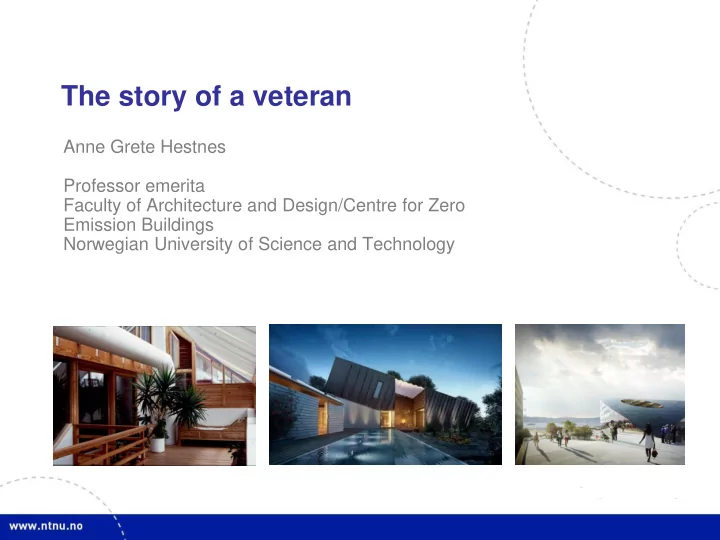

The story of a veteran Anne Grete Hestnes Professor emerita Faculty of Architecture and Design/Centre for Zero Emission Buildings Norwegian University of Science and Technology
My career in solar Hired at a Norwegian research institute (SINTEF) to design Norway’s first solar house 1977: 1982 (?): Served as chairman of the Norwegian Solar Energy Association (four terms) Attended my first ISES Board meetings (as observer, representing the Norwegian association) 1985: Awarded a full professorship in architecture at the Norwegian University of Science and Technology (specialization – energy use in buildings) 1998-2000:President of ISES Europe 2001-2003: President of ISES Received the Farrington Daniels Award (for “contribution to the advancement and 2011: knowledge of energy conservation and solar energy in the built environment”) Refuge du Gouter, France Other relevant activities: Chairman of the conference North Sun’92 International chairman of Eurosun 2000 Scientific chairman of Eurosun 2002 Associate and guest editor of Solar Energy (1996-2006) Project leader (Operating Agent) for IEA’s Solar Heating and Cooling Programme’s Task 13 and Task 23 (1988-2002)
My professional story – in line with the story of solar in Norway from systems based on air to systems based on water to photovoltaics from passive solar to active solar to hybrid systems to solar buildings from single technologies to whole building design from solar buildings to solar architecture from passive solar to zero emission buildings and neighborhoods and Solar Cities?
At the start: Sunspaces and atria Amenity value more important than energy savings Dwelling at 63 o N - Malvik IEA SHC Task 8 case study) My own sunspace, 35 years old and still a delight. University campus at 63 o N - NTNU (At 63 o N - Trondheim) (IEA SHC Task 11 case study)
The trends I see: Continuing reductions in energy use per m 2 (as a result of stricter building codes and ..) Higher ambient temperatures (as a result of climate change?) Several consequences: Less need for space heating (and concentrated to the relatively darker winter months) More need for space cooling Relatively greater need for heating of DHW Much more focus on electricity - Passive solar heating systems partly out except windows/direct gain - Passive solar cooling systems in I.e.: primarily ventilation - Active solar heating of DHW most important - PV always useful = Solar buildings
At the same time: Solar thermal: Towards building integration Better potential for cost effectiveness Both for solar thermal systems and for PV systems PV:
Building integration/architectural integration an issue for architects Retrofit, Bergen Cultural Center, Os Brynseng school, Oslo
The focus now is on environmental issues rather than on solar as such. Therefore: Zero emission buildings Refuge du Arpont, France Powerhouse I, Trondheim Refuge du Gouter, France Source: Skanska a challenge also for architects «Form follows energy» ? Monte Rosa Hütte, Switzerland Source: V.Wittwer
Zero emission - Architectural consequences ” Zero Energy Buildings are designed to perform well, be comfortable, require only standard maintenance, and look no different than ordinary buildings ”. Quote : NREL/U.S.DOE Nonsense! Zero emission buildings will have many different architectural expressions and provide many architectural possibilities! Architect: Coop Himmelblau Source: Klaudia Farkas, NTNU
A Norwegian example: Powerhouse Brattørkaia Office building planned as “plus energy house” Alliance: Entra, Skanska, Snøhetta, Hydro, ZERO Location: Trondheim Size: 7 stories, ~ 7000 m² TFA Illustrates two trends: The trendsetting architects now like to use solar systems (especially PV). The design of such buildings require so-called integrated design processes – where all the actors cooperate from the start. “The integrated design process has been crucial in the development of this project.” Quote: T.Hegli, Snøhetta Source illustrations: Skanska
And women in solar? Continually increasing number of Refuge du Arpont, France female students! Women especially interested in environmental issues. The future looks bright!! Refuge du Gouter, France Students at a seminar in our international MSc- program on Zero Emission Buildings
Recommend
More recommend